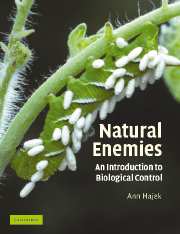Book contents
- Frontmatter
- Contents
- Preface
- Acknowledgments
- Introduction
- PART I Strategies for using natural enemies
- PART II Biological control of invertebrate and vertebrate pests
- PART III Biological control of weeds
- PART IV Biological control of plant pathogens and plant parasitic nematodes
- Chapter 16 Biology and ecology of antagonists
- Chapter 17 Microbial antagonists combating plant pathogens and plant parasitic nematodes
- PART V Biological control: concerns, changes, and challenges
- Glossary
- References
- Index
Chapter 17 - Microbial antagonists combating plant pathogens and plant parasitic nematodes
Published online by Cambridge University Press: 05 June 2012
- Frontmatter
- Contents
- Preface
- Acknowledgments
- Introduction
- PART I Strategies for using natural enemies
- PART II Biological control of invertebrate and vertebrate pests
- PART III Biological control of weeds
- PART IV Biological control of plant pathogens and plant parasitic nematodes
- Chapter 16 Biology and ecology of antagonists
- Chapter 17 Microbial antagonists combating plant pathogens and plant parasitic nematodes
- PART V Biological control: concerns, changes, and challenges
- Glossary
- References
- Index
Summary
In the field of plant pathology, the focus for biological control is on suppressing plant disease, much more than on thinking of biological control as controlling specific individual organisms that cause disease. It follows that emphasis is placed on use of antagonists to make certain that plants are not injured, while entomologists working in biological control often place more emphasis on impacts of natural enemies on densities of specific pests.
Finding antagonists
When antagonists are present in the correct microhabitat and are active, plant disease does not occur. However, lack of disease does not especially prove that antagonists are present because while the pathogen may be absent conditions might not be correct for the pathogen to be active so its presence would go undetected. Even if disease is occurring, antagonists might be present yet inactive. How are antagonists of plant pathogens found? Typically, they are isolated from the same habitats where their target pathogens live – from plant tissues or from the soil. Sometimes in a field of diseased plants, a few plants are very obviously healthy. These healthy plants might have escaped disease due to the presence of naturally occurring antagonists that suppress the pathogen affecting neighboring plants. Microbes isolated from the healthy plants have the promise of being antagonists. Antagonists occurring in the soil have been identified in much the same way as those isolated from healthy plants.
- Type
- Chapter
- Information
- Natural EnemiesAn Introduction to Biological Control, pp. 277 - 294Publisher: Cambridge University PressPrint publication year: 2004



